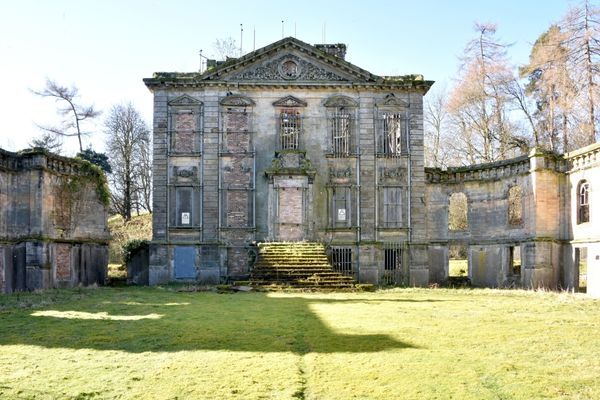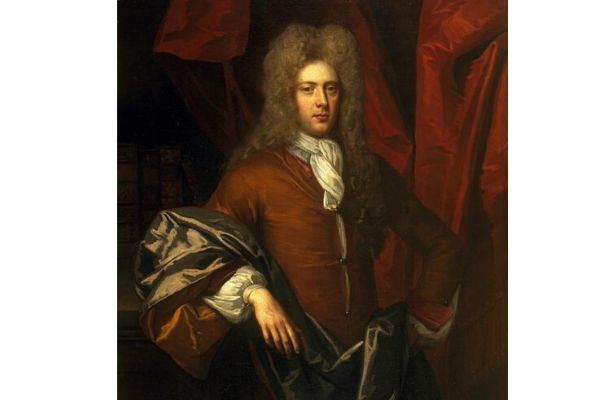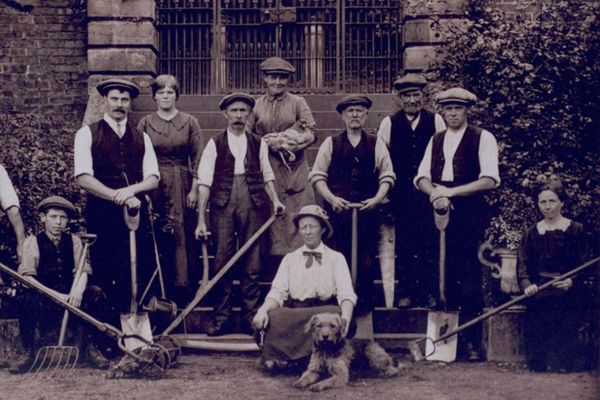Landmark is thrilled to have been prompted to apply for a National Heritage Memorial Fund (NHMF) grant to save one of the most important British buildings at risk from imminent collapse.
The NHMF exists as the funder of last resort to save the nation’s greatest treasures. Mavisbank, one of the nation’s most intractable conservation problems, will certainly be lost without their financial help. Landmark, with its long experience in rescuing buildings and providing them with a sustainable future, is now the only hope for Mavisbank’s survival.
An NHMF grant in the region of £5m would enable Landmark to pursue phase one of a fresh plan to give Mavisbank House a vibrant and sustainable future. This vital phase would see the crumbling building and pavilions stabilised before any more historic fabric falls away, enable up-to-date condition surveys and resolve the long-standing ownership and access issues.
‘For 50 years this 18th-century gem, designed by William Adam and a trailblazer of the Scottish Enlightenment, has been in profound jeopardy: its ownership unknown, its condition parlous and its fabric inaccessible. Mavisbank is now at the end of its road: if a solution is not found, absolute loss is all but inevitable’.
Dr Anna Keay OBE, Director of the Landmark Trust
 The derelict exterior of Mavisbank House.
The derelict exterior of Mavisbank House.
Following the success of its ‘Expression of Interest’ application to the NHMF, Landmark will now develop and submit a full grant application to fund the initial phase of Landmark’s rescue plan. This phase would deliver critical stabilisation works, unlocking training opportunities through the employment of masonry apprentices. We would plan for free public access to view the house throughout the repair works, interpretation of the conservation works and periodic deeper access to special interest groups, students and others.
These works would provide the crucial foundation for a second phase, after a further round of fundraising. This later phase would restore and convert the house using specialist craft skills to give it a new use as self-catering accommodation. For the first time in 50 years, Mavisbank’s future would be secure and self-supporting. It would be accessible to all, whether for a holiday, as part of Landmark’s free stay programmes for charities, or by visiting on free public open days. Mavisbank’s remarkable history could at last be celebrated fully. Mavisbank would join 20 other Landmarks dotted across Scotland, including the recently rescued Fairburn Tower near Inverness.
Midlothian Council is a supportive stakeholder in the project and, as part of the phase one funding, has agreed to use its statutory power of compulsory purchase to acquire legal title to the house as the owner has been untraceable for decades. The historic landscape around the house is managed by Historic Environment Scotland on behalf of Scottish Ministers and is not part of this project. It will remain accessible to the community. We will be working with HES to explore access options.
Mavisbank is of outstanding importance to Scottish and British national heritage and is widely-recognised as ‘a building of European significance’ (Ian Gow, Buildings of Scotland: Lothian, Pevsner Architectural Series, 2023 edition).
Sign up for updates about our plans and share your views
History
Built by Scotland’s foremost architect
Mavisbank is best known as the first Palladian house in Scotland. Listed Category A, it was built in the 1720s and designed by Scotland’s foremost architect, William Adam, and his sophisticated and cosmopolitan client, Sir John Clerk of Penicuik. Clerk’s education in Leiden and travels through Europe in the 1690s gave him an experience of European buildings and culture. Following the custom of Classical writers, his creation at Mavisbank was Clerk’s realisation of a classical villa, for civilised retreat to the countryside, away from hectic life in Edinburgh or the formality of the main family seat at nearby Penicuik. He elaborated his vision in a long poem called 'The Country Seat' that was circulated widely among his peers. Mavisbank brought Palladianism to Scotland, prompting a sweeping change in architectural style and cultural outlook. A remarkably complete family archive preserves the design process in detail.
Sir John Clerk was at the forefront of the Scottish Enlightenment in a new ‘British’ age. He played a key role negotiating the Act of Union between Scotland and England in 1707, leading to the creation of the United Kingdom of Great Britain. As a Baron of the Exchequer he subsequently contributed to initiatives to expand Scottish trade and industry, and was proud that he built Mavisbank entirely from this salary rather than the income from his estates. The last 40 years of his life were spent writing a six-volume history of the relationship between England and Scotland.
 John Clerk of Penicuik © National Galleries Scotland
John Clerk of Penicuik © National Galleries Scotland
Groundbreaking mental health treatment
After bursting so brilliantly on the scene, Mavisbank fell out of family use in the late 18th century and was sold on in 1811. In 1876 it was bought by a group of pioneering Edinburgh doctors as a private asylum which broke new ground in the treatment of mental illness. It was extended and renamed New Saughton Hall. Dr John Batty Tuke, the asylum’s director, helped modernise mental health practices through more humane treatment of patients, and promoted more compassionate national legislation on ‘Lunacy’. Tuke worked to understand the causes of mental illness to improve the lot of those suffering, and advocated its treatment as a medical (rather than a criminal) condition.
Mavisbank patients were encouraged to participate in pioneering practical gardening therapies under its remarkable Head Gardener Mary E. Burton, self-educated and the first female professional gardener in Scotland. Navigating what was then an exclusively masculine profession, she later became the first female president of the Scottish Horticultural Association. During the First World War, soldiers discharged for ill-health and shell-shock were among the patients at Mavisbank, which served as a mental asylum for almost 80 years. There is much more to be discovered about those who found shelter here.
 Head Gardener Mary E. Burton (seated) with her team of gardeners which included patients from the asylum.
Head Gardener Mary E. Burton (seated) with her team of gardeners which included patients from the asylum.
Neglected for 50 years
The asylum closed in the 1950s and was sold again to a private owner, who used it as, among other things, a car breakers yard. A disastrous fire in 1973 was followed by wilful neglect and then abandonment. The building was left roofless and largely floorless, its ownership uncertain after the death of its owner. Now stripped back to its 1720s shell, it has long been on the Buildings at Risk Register categorised as ‘High Risk’ and in ‘Ruinous’ condition. It was saved from outright demolition in 1987 only thanks to a public outcry and a group of volunteers. Historic Environment Scotland, who manage the policies and parkland, have kept the building scaffolded in recent years to prevent total collapse but can do no more than this.
The building has been without an identified owner for over 40 years. Without resolution of this obstacle of ownership, the building cannot be saved. In March 2023 Midlothian Council agreed to use its compulsory purchase powers to help secure the building's future.
For almost 30 years, passionate attempts have been made to solve Mavisbank’s complex problems but have come to nothing. Landmark is not used to giving up. We have learned from past campaigns and are now firm in our resolution that our current plan will finally save the building once and for all. The green light from the NHMF to apply for a grant to acquire and consolidate Mavisbank means we are now off the starting block.
Mavisbank Presentation ©Historic Environment Scotland from The Landmark Trust on Vimeo.
Sign up for updates about our plans and share your views